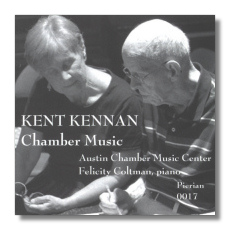
The Internet's Premier Classical Music Source
Related Links
- Kennan Reviews
- Latest Reviews
- More Reviews
-
By Composer
-
Collections
DVD & Blu-ray
Books
Concert Reviews
Articles/Interviews
Software
Audio
Search Amazon
Recommended Links
Site News
 CD Review
CD Review
Kent Kennan

Chamber Music
- Sonata for Violin & Piano "Sea Sonata" (1937) 1
- Night Soliloquy for Flute and Piano (1936)
- Scherzo, Aria & Fugato for Oboe and Piano (1949)
- Threnody for Violin and Piano (1992) 2
- Quintet for Piano and Strings (1935) 3
1 Richard Kilmer, violin
Megan Meisenbach, flute
Kathleen Turner, oboe
Felicity Coltman, piano
2,3 Adrianna Hulscher, violin
3 Jennifer Bourianoff, violin
3 Ames Asbell, viola
3 Margaret Coltman-Smith, cello
Pierian 17 54:07
Summary for the Busy Executive: Jewels.
Like Harold Shapero, the composer Kent Kennan (1913-2003) stopped writing music with many potentially productive years to go. Because I don't know why, Kennan seems to me mysterious, a subject for Erle Stanley Gardner – The Case of the Curious Composer, perhaps. Kennan stopped in 1956. Although he turned out the occasional morceau, he never attempted a large piece again.
The Night Soliloquy of 1936 in its orchestral dress introduced me to Kennan through Howard Hanson's classic recording. Several brass-playing friends of mine learned the trumpet sonata. These two works probably constitute Kennan's hits. However, I should also say that most of Kennan's work hasn't had enough of a chance with listeners. Based on what I've heard here, other pieces in his catalogue may stick. Kennan studied at Eastman and learned a great amount of craft. Indeed, he became the author of two widely-used textbooks: Counterpoint (which I once worked through) and The Technique of Orchestration. I must say that I have heard only one big score by Kennan, the violin sonata on this CD. Consequently, he strikes me as a lyric, rather than as an epic poet, although I've heard rumors of a symphony. Only one of the pieces on this CD lasts beyond fifteen minutes. So his later confinement to, in effect, Albumblätter seems in keeping with his more active career. He probably just turned out fewer of them.
The "Sea Sonata," a curiously old-fashioned piece, in places reminds me a little of Bernard Rogers, although I doubt Kennan studied with him. It's more a matter of an "Eastman attitude" than anything else. Nevertheless, one feels a hard nugget of originality at its core. Even at this early date (1937), one finds a characteristic elegance, the drive to say as much in as few notes as possible – this, despite the late nineteenth-century idiom. There's no filler or padding in any of this music. Kennan works conscientiously. That may be why so many of the pieces are so short. Kennan generates the entire sonata from a small kit of ideas, extending his economy, even as he evokes the turbulence of the sea.
The earlier piano quintet strikes me as an odd mixture of Brahms and proto-Impressionism. The first movement has that heavy, three-quarter, juggernaut movement characteristic of Brahms, but the harmonies are very French. The second movement tolls funeral bells, with modal ideas heavily colored by a flatted seventh. The finale is a quick scherzo. It doesn't last long, but it sums up the quintet satisfactorily.
Night Soliloquy leans even more to the French side of things, a more astringent version of Griffes's Poem for flute and orchestra. It's nice hearing the chamber version for flute and piano. In fact, it slightly changes the character of the piece to a more pronounced tartness.
Kennan didn't stand still. Even in his last pieces, he was appropriating the techniques of much younger writers, but always with a concern for expressive poetry. The oboe piece here adopts a neoclassical, Hindemithian point of view and sound-world. The Threnody knits twisty little lines (Kennan seems eager to use all twelve tones of the scale) to create a chromatics of grief. Nevertheless, it's the grief that's important, not the technical means. Kennan always submits his craft to the service of expressivity.
The performances are okay, with the wind players coming off better than the strings, some of whom have minor intonation problems. These hit Richard Kilmer in the violin sonata, and his tone sounds dull, like a singer suffering from a bad head cold. Adrianna Hulscher does better in the Threnody. The first movement of the piano quintet sounds slightly out, although the situation improves as the ensemble goes along. The real rock here is pianist Felicity Coltman, who lays down a carpet of support for everybody. But these are all minor issues. The star of the recording is Kennan's music – honest, graceful, and poetic.
Copyright © 2008, Steve Schwartz




















